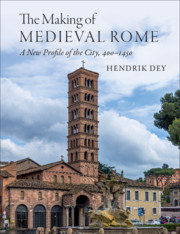Book contents
- The Making of Medieval Rome
- The Making of Medieval Rome
- Copyright page
- Contents
- Preface
- Introduction
- Chapter 1 The Eternal City on the Brink
- Chapter 2 401–552
- Chapter 3 552–705
- Chapter 4 705–882
- Chapter 5 The Long Twilight of the Early Middle Ages
- Chapter 6 1046–1230
- Chapter 7 1230–1420
- Epilogue
- Notes
- References
- Index
Chapter 6 - 1046–1230
Church Reformed, Senate Reborn, Rome Renascent
Published online by Cambridge University Press: 30 September 2021
- The Making of Medieval Rome
- The Making of Medieval Rome
- Copyright page
- Contents
- Preface
- Introduction
- Chapter 1 The Eternal City on the Brink
- Chapter 2 401–552
- Chapter 3 552–705
- Chapter 4 705–882
- Chapter 5 The Long Twilight of the Early Middle Ages
- Chapter 6 1046–1230
- Chapter 7 1230–1420
- Epilogue
- Notes
- References
- Index
Summary
The relative textual and archaeological invisibility of the 10th and 11th centuries at Rome is especially vexing for coming at a critical transitional period, just when the early medieval city began to metamorphose into the very different sort of place it became in the later Middle Ages. The later medieval city as it emerged from the 12th century on broke with its ancient roots in a number of ways. At least as late as the 9th century, upper-class residences like the ones in the Forum of Nerva retained a distinctly unfortified profile; though these houses were smaller and more compact than the aristocratic mansions of imperial Rome, they nonetheless prolonged a tradition of accessible, ‘civilian’ residential architecture that had continued unbroken for a thousand years. By the 12th century, however, Roman nobles lived in fortified compounds, complete with defensible outer walls and tall towers. As late as the 10th and 11th centuries, very few churches had bell towers, either; the soaring, graceful campanili attached to surviving medieval churches only proliferated in the 12th. In the 9th and 10th centuries, patches of settlement still extended across much of the intramural area.
- Type
- Chapter
- Information
- The Making of Medieval RomeA New Profile of the City, 400 – 1420, pp. 170 - 213Publisher: Cambridge University PressPrint publication year: 2021



